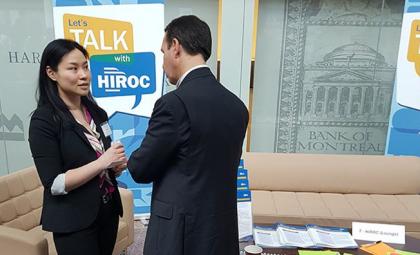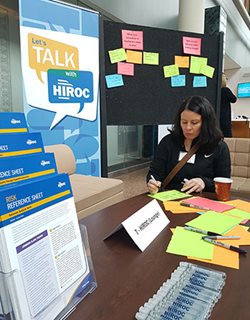When possibilities become reality

HOW INNOVATIONEX IS NOT ONLY LEADING THE CONVERSATION, BUT ALSO THE RAPID EXECUTION OF NEW IDEAS
Monday, June 04, 2018 – Philip De Souza
“This is my favourite day of the year,” exclaimed Sarah Downey, President and CEO of Michael Garron Hospital. Downey – who moderated the Learning Exchange at this year’s InnovationEX, hosted by the Joint Centres for Transformative Healthcare Innovation – is clearly a strong supporter. “This event gets better and better every year,” she said.
The Joint Centres is a partnership between seven large community hospitals focused on collaboration and sharing. For Humber River Hospital, Mackenzie Health, Markham Stouffville Hospital, Michael Garron Hospital (MGH), North York General Hospital (NYGH), Southlake Regional Health Centre, and St Joseph’s Health Centre Toronto, the goal is to improve quality, safety and performance in healthcare.
This year’s theme was innovating to reduce harm, “We know the stats – one in 18 will experience preventable harm,” said Downey; “it’s our responsibility to learn from these events and prevent them from happening again.”
The morning was kicked off with a touching video of a patient’s family member talking about the impact of harm. “It’s events like this that offer us the forum to have the tough conversations, share and learn from each other,” said Downey. “It shows great maturity to speak openly to not blame and shame, but continue our focus on building a stronger system together,” she added.
TALK, EXPLORE, LEARN
The keynote offered by Patricia Trbovich focused on human factors approach, but also touched upon the importance of resiliency. Trbovich is the Badeau Family Research Chair in Patient Safety and Quality Improvement at NYGH. She shared some sobering imagery to illustrate how healthcare has changed so much; starting with an image of where we came from – an ED with many healthcare workers busy tending to patients, and one from present day where healthcare workers are alongside technology helping patients.
It was definitely a moment to take pause, “Despite the fact that we’ve seen how technology and innovation are pushing us forward with care,” said Trbovich, “it can also be seen as making the person-to-person interaction worse, and ultimately gives us food for thought when thinking about innovation increasing costs in healthcare.”
“Human factors approach has been around for decades, we see it in the aviation sector and now its prominence in healthcare is gaining momentum,” added Trbovich.
Trbovich explained how the approach is the study of how people interact physically and psychologically with products, tools, procedures and processes – looking at all of these factors as one entire system and not in isolation.
The approach forces people to spend time in the environment to truly understand what is required to reduce complications. More importantly, it’s about asking ourselves how we are setting up peoples’ work and routines.
Dr. David Smith, General Surgeon at NYGH and a panelist, agreed with Trbovich’s thoughts – “Human factors improves patient safety, saves lives and improves team dynamics,” he said. Smith emphasized the value in engaging the frontline and also ensuring leadership support is there to facilitate open conversations.
Circling back to resiliency, Trbovich highlighted the Miracle on the Hudson when Captain Sully landed his aircraft on the Hudson River, “That was a perfect example of resiliency in a moment of chaos,” she said.
 Trbovich stressed the importance of investing in our people and ensuring we’re paying attention to team dynamics, communication, and psychological safety. She echoed thoughts similar to HIROC’s Polly Stevens, VP of Healthcare Risk Management in The “secret sauce” of successful teams. Both Trbovich and Stevens touch on the Google initiative that studied hundreds of teams and identified the critical importance of psychological safety and the correlation to team outcomes.
Trbovich stressed the importance of investing in our people and ensuring we’re paying attention to team dynamics, communication, and psychological safety. She echoed thoughts similar to HIROC’s Polly Stevens, VP of Healthcare Risk Management in The “secret sauce” of successful teams. Both Trbovich and Stevens touch on the Google initiative that studied hundreds of teams and identified the critical importance of psychological safety and the correlation to team outcomes.
Trbovich ended her thought-provoking talk with a quote from Einstein, “The intuitive mind is a sacred gift and the rational mind is a faithful servant. We have created a society that honours the servant and has forgotten the gift.”
She closed with a call for greater accountability, compassion, and integrity when thinking about how we can all implement a human factors approach in our organizations.
“This forum and the Joint Centres group is a true testament to the innovation at work in our ever-evolving healthcare system – moving conversations to simulation, and ultimately to reality for all,” said Catherine Gaulton, CEO of HIROC. Gaulton addressed attendees during the close of the talk. “The focus on human factors approach is something that will impact not only the communities we care for, but will surely have an impact on dollars too,” she said. “At HIROC we are pleased to support your work and this commitment to safety for all.”
SPOTLIGHT ON INNOVATION MAVERICKS
The remainder of the forum saw the spotlight shift to the various teams from the Joint Centres group – all showcasing how they are making a difference at their respective organizations to drive change through innovation.
SPEAKERS' CORNER
At the HIROC booth attendees shared their thoughts on innovation – what it means to them, and how they are leading change. Here are a few of the things we heard.
“Innovation is applying knowledge in a NEW way!”
“Innovation means collaboration.”
“Being open minded and curious breeds innovation.
“Innovation means making it easy to do the right thing.”
“Inclusivity of front-line staff in innovation is very important.”
“We are always reminding ourselves why we are here – for the patients and families we serve.”
“We are working to make it simple, simple, simple!”
“We are leading change with inclusive patient safety huddles where everyone is involved.”
It’s clear that there are some truly amazing initiatives at work, making the future feel that much brighter.
Philip De Souza is Manager, Communications and Marketing, HIROC